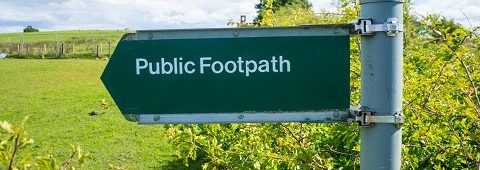This website uses cookies so that we can provide you with the best user experience possible. Cookie information is stored in your browser and performs functions such as recognising you when you return to our website and helping our team to understand which sections of the website you find most interesting and useful.

Whether you own a couple of acres of paddock or hundreds of acres of upland moor, don’t ever overlook your rights and responsibilities when it comes to public rights of way.
The general position in law is that the land owner owns the land that forms part of any public right of way and, as a result, is responsible for its maintenance and upkeep and importantly ensuring it is free from obstruction enabling the public free passage over the whole width of the public right of way at all times.
Stiles and Gates
Generally these are situated for the benefit of the land owner. They form part of the right of way and are therefore maintained by the owner. Loss or injury caused to the public by dangerous or defective items could give rise to a civil claim. Gates and other structures should therefore be regularly inspected kept in a safe condition. It is possible to claim 25% of the reasonable costs in undertaking maintenance from the local Highways Authority. It has been known for some local authorities to maintain such structures and even replace when necessary, regardless of whose obligation it is to do so.
Obstruction
It should go without saying that building or fencing across or otherwise permanently obstructing the whole or part of any public right of way can be a criminal offence.
A land owner is legally entitled to fence along any part or the whole of a right of way and many land owners chose to do so as it is an effective method of keeping the public and livestock quite separate.
If the land owner opts for barbed wire or electric fencing then it should be set back off the boundary of the right of way and should include suitable warning signs at regular intervals.
Farming Activity
The land owner is entitled to continue to farm in, over and around the public right of way. The obligation to keep free from obstruction will prevent the growing of crops over a right of way but does not prevent the area from being ploughed or otherwise cultivated. A cross field footpath should be a minimum of 1 metre in width and 2 metres, in the case of cross field bridleways.
Ongoing maintenance
The most common responsibility in respect of public rights of way is controlling vegetation that overhangs the highway. Hedges bring their own problems not only causing obstruction but also reducing visibility along the highway. Some Highways Authorities undertake regular maintenance of highway hedgerows to ensure a safe environment for all, but they are entitled to serve notice on a land owner requiring obstructing vegetation to be removed in just 14 days.
If you are affected by any issues relating to public rights of way and would like further advice or assistance, contact Jamie Brown Head of our Agricultural Team.
Share this post:
